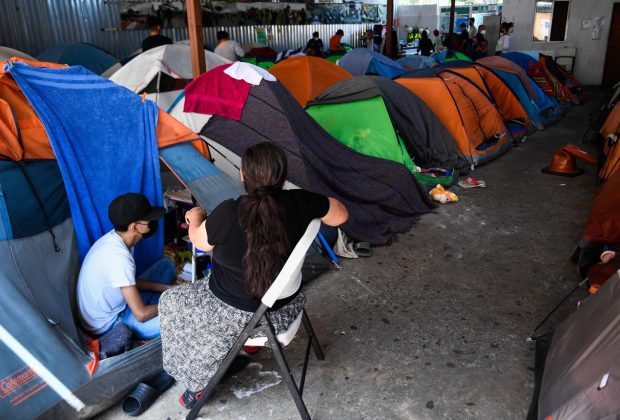Policy denies U.S. entry to Central Americans seeking asylum while their claims are pending.
By Jess Bravin | The Wall Street Journal | JUN. 30, 2022 | Photo by Patrick T. Fallon for AFP/Getty
WASHINGTON—The Supreme Court ruled 5-4 that the Biden administration could cancel the Trump-era “Remain in Mexico” program, which required authorities either to jail asylum applicants from Central America or deny them U.S. entry until their cases are resolved.
The court found the Biden administration acted within its discretion by ending the program, overturning lower-court rulings that required the Department of Homeland Security to enforce the policy, which President Biden campaigned on ending.
Writing for the court, Chief Justice John Roberts noted that Congress never has provided sufficient funding to detain the vast numbers of migrants seeking asylum. At the same time, the U.S. cannot unilaterally expel to Mexico the citizens of Central American countries covered by the policy.
The lower court “imposed a significant burden upon the Executive’s ability to conduct diplomatic relations with Mexico,” the chief justice wrote, joined by Justices Stephen Breyer, Sonia Sotomayor, Elena Kagan, and Brett Kavanaugh. It forced the government “to the bargaining table with Mexico, over a policy that both countries wish to terminate,” and asserted authority “to supervise its continuing negotiations with Mexico to ensure that they are conducted ‘in good faith.’”
Congress couldn’t have intended to hand a federal judge such power over American foreign policy, the court concluded.
Texas and Missouri, both Republican-led states, sued to stop the administration from ending the policy, known formally as the Migrant Protection Protocols. Lower courts, including the Fifth U.S. Circuit Court of Appeals, in New Orleans, found several reasons to keep it in place.
Among other arguments, the states contended that the Biden administration failed to follow required administrative procedures in changing the policy, and for authority cited the Supreme Court’s 2019 decision rejecting the Trump administration’s plan to require that census forms ask whether respondents had U.S. citizenship.
Justice Roberts, who also wrote the 2019 decision, said the comparison was inapt. In the census case, the Trump administration said it needed the data to help protect minorities from discrimination under the Voting Rights Act of 1965. The Supreme Court, like several lower courts, found that claim to be a pretext.
In his ruling Thursday, the chief justice wrote that while there were indications of “bad faith or improper behavior” by the Trump administration’s actions on the census, “nothing in this record suggests a ‘significant mismatch between the decision the Secretary made and the rationale he provided’” for terminating “Remain in Mexico.”
The principal dissent, by Justice Samuel Alito, noted the crisis at the southern border.
“In fiscal year 2021, the Border Patrol reported more than 1.7 million encounters with aliens along the Mexican border,” he wrote.
Due to those high numbers, Justice Alito wrote, the government lacks “the capacity to detain all inadmissible migrants encountered at the border.” But rather than return them “to Mexico while they await proceedings in this country, DHS has concluded that it may forgo that option altogether and instead simply release into this country untold numbers of aliens” whose asylum applications likely will be denied, he wrote.
Justices Clarence Thomas and Neil Gorsuch joined the Alito dissent. Justice Amy Coney Barrett, joined by the other three, filed a separate dissent raising procedural objections to hearing the case.
“The administration dragged its feet and refused to implement this effective program in good faith, allowing hundreds of thousands of illegals to pour over the border month after month,” said Texas Attorney General Ken Paxton, a Republican. “Today’s decision makes the border crisis worse.”
The Department of Homeland Security said it was moving ahead to end Remain in Mexico.
The program “has endemic flaws, imposes unjustifiable human costs, and pulls resources and personnel away from other priority efforts to secure our border,” it said in a statement. “The Department also continues to enforce our immigration laws at the border and administer consequences for those who enter unlawfully.”
The Biden administration argued that the public benefit of releasing some migrants was preserving beds in immigration lockups for noncitizens considered a particular security risk, such as those with criminal records.
Remain in Mexico drew immediate controversy when announced but was largely sidelined during the coronavirus pandemic. The Trump administration relied on other authorities to deny admission to migrants, particularly public-health orders under a provision known as Title 42, a pandemic-era border policy that prevents migrants at the U.S.-Mexico border from asking for asylum.
The Biden administration continued that practice but has encountered opposition, including from some Democrats, over plans to end Title 42 exclusions while waves of Central Americans seek to cross the border.
The Biden administration says the Remain in Mexico program exposes asylum applicants, including mothers with children, to unsafe conditions. The administration says it can ease the burden on the immigration system through other means, such as hiring more hearing officers who could cut processing time to six months from current waits that can last years.
Even when the Remain in Mexico policy was in effect, the Biden administration said, immigration officers sent only about 6.5% of Central Americans seeking asylum to wait in Mexico for processing. According to the court, some 68,000 migrants were enrolled in the program at the end of 2020.
The Migrant Protection Protocols were introduced in 2019 at the height of a surge in Central American families coming to the U.S. border. After the policy was announced, border crossings fell sharply. But migrants sent back to Mexico faced a range of dangers, including assault, kidnapping and murder, according to reports from human-rights groups and internal DHS reports.
The Trump administration argued Remain in Mexico was necessary because it reduced incentives to migrate, as those making asylum claims wouldn’t be allowed to live and work in the U.S. while they wait for their cases to be resolved, a process that routinely took years. Monthly border crossings fell by about 75% in the six months following their peak in May 2019, when the program was expanded border-wide.







